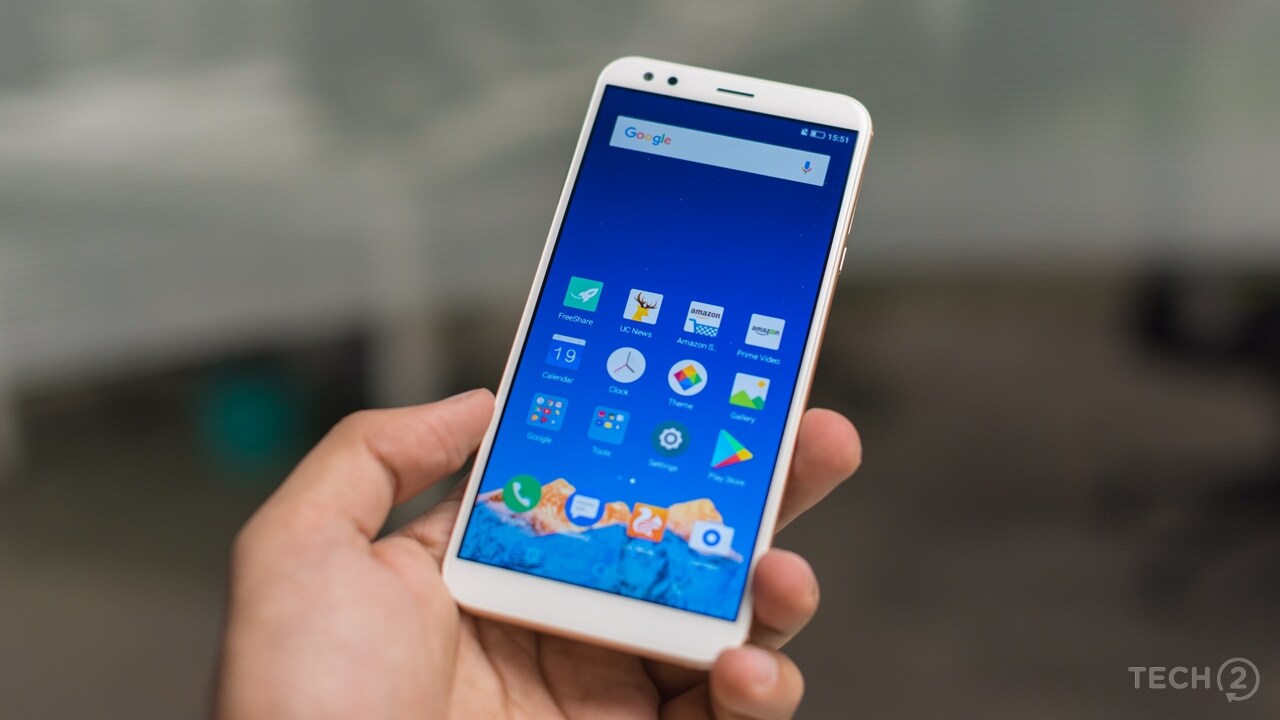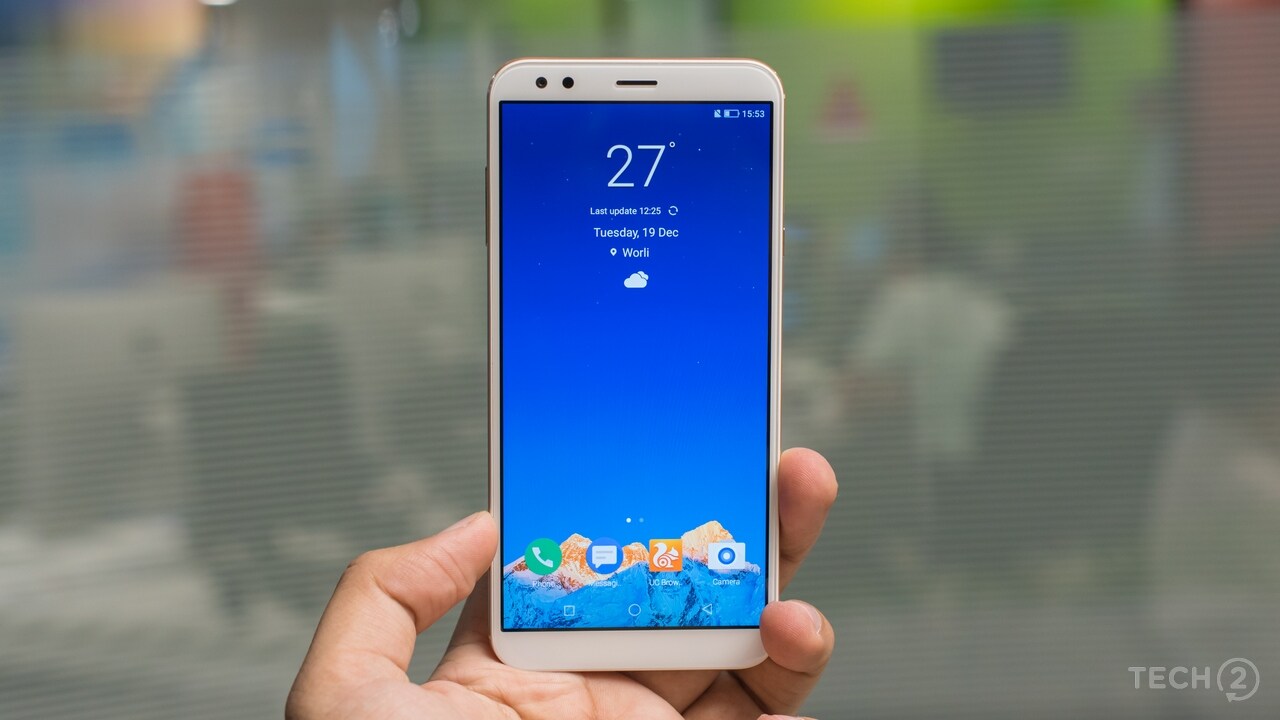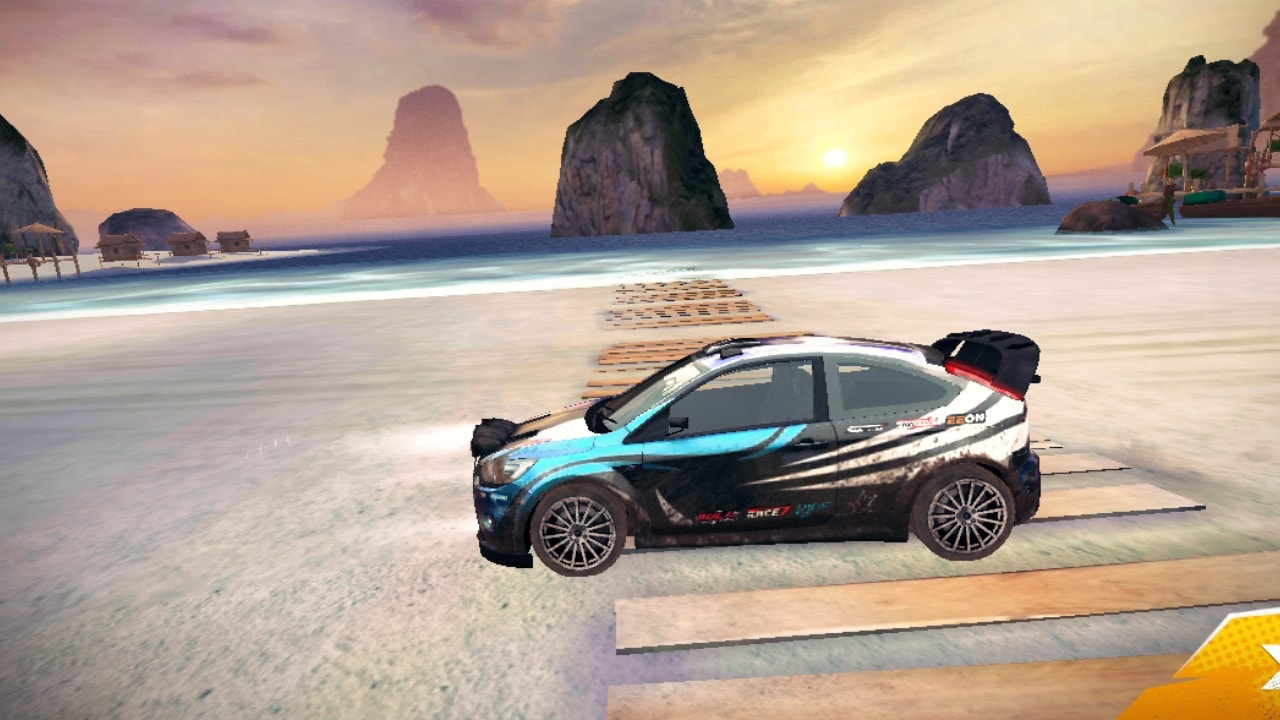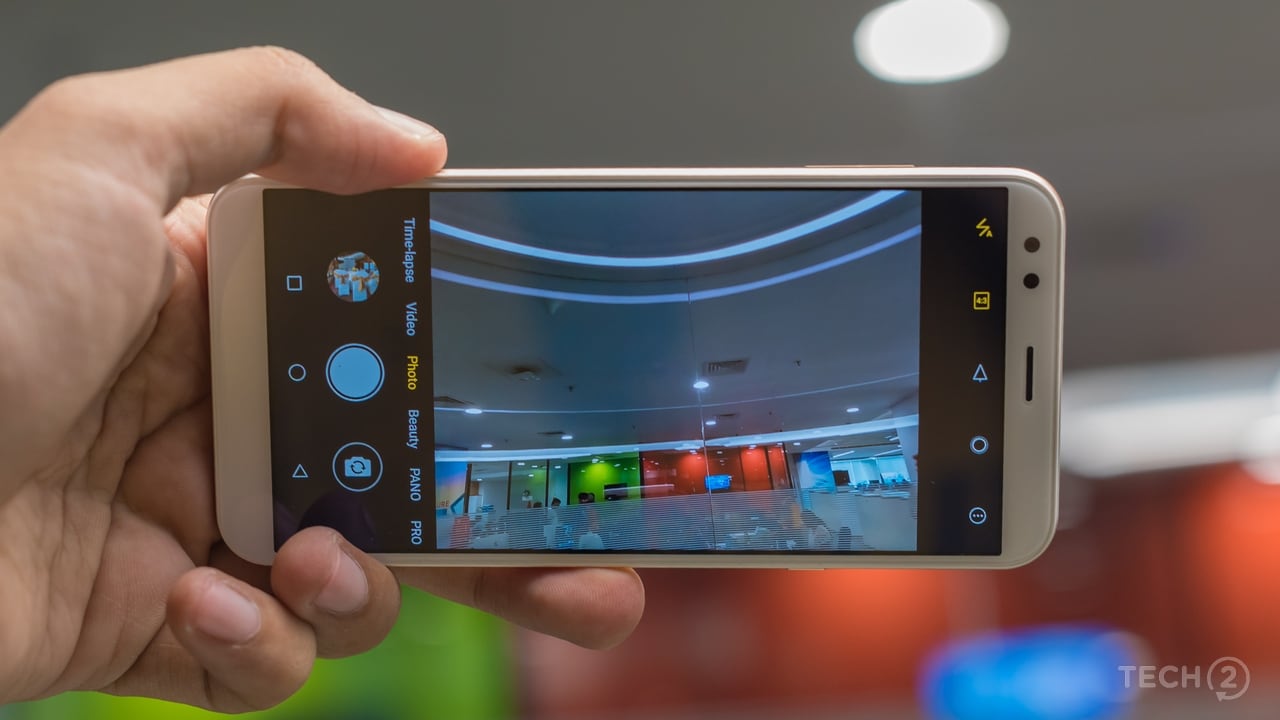While we have yet to finish off with the first month of 2018, it is hard to fathom, how many entry-level and budget smartphones have already been announced in India by various smartphone brands. [caption id=“attachment_4325099” align=“alignleft” width=“380”] The Infocus Vision 3 Image: Tech2/Rehan Hooda[/caption] With that said, manufacturers are cutting costs by cutting down on quality and coming up with shortcuts to offer smartphones that appear to offer more for a lot less. When I took delivery of the InFocus Vision 3 for review, I assumed that this again would be the typical entry-level smartphone. A device that aims to dethrone the plethora of Chinese smartphone options from Xiaomi, something that few have been able to achieve with success. A week later, that opinion has changed a bit. As the feature-packed InFocus Vision 3 offers more than what any other smartphone brand has on offer in its class. Sadly, though it still isn’t enough to beat the value for money Xiaomi Redmi 5A and last year’s winner, the Redmi 4. Build and Design: 6.5/10 At Rs 6,999 asking for a great smartphone design that stands out is asking for too much. So for its price, the painted plastic body seems good enough. The Vision 3 is a well-finished product but it does feel a bit heavy for its size at 150 g. The weight makes up for the plastic body, adding to the heft giving you reassurance that this phone is indeed packed to the brim with features. [caption id=“attachment_4325109” align=“alignnone” width=“1280”]
 The added heft thanks to the massive battery, lends some confidence to the all plastic body. Image: Tech2/Rehan Hooda[/caption] The InFocus Vision 3 features the same old design with rounded corners and a rounded plastic back that looks a bit dated in my opinion, despite the fact that it features an 18:9 aspect ratio display on the front. It’s not a bezel-less design, but it does offer the highest display to body ratio in front of the competition. [caption id=“attachment_4325119” align=“alignnone” width=“1280”]
The added heft thanks to the massive battery, lends some confidence to the all plastic body. Image: Tech2/Rehan Hooda[/caption] The InFocus Vision 3 features the same old design with rounded corners and a rounded plastic back that looks a bit dated in my opinion, despite the fact that it features an 18:9 aspect ratio display on the front. It’s not a bezel-less design, but it does offer the highest display to body ratio in front of the competition. [caption id=“attachment_4325119” align=“alignnone” width=“1280”] Those antenna bands are fake. Image: Tech2/Rehan Hooda[/caption] Despite InFocus’ efforts to make you believe that the smartphone’s body is constructed out of metal (there are fake antenna bands on the back) it is anything but that and you notice this as soon as you pick up the device as it doesn’t feel cool unlike some of the metal clad offerings in the market. Indeed, this is one area where the Xiaomi Redmi 4 wins because it features a metal back and feels better overall, despite its thicker and more rounded appearance. Features: 7/10 At Rs 6,999, the InFocus Vision 3 offers plenty of bang for your buck. There’s that 5.7-inch HD+ 18:9 aspect ratio Full Vision LCD display with 2.5D glass on the front. Inside, you get a MediaTek MTK 6737H chipset with a quad-core 1.3GHz processor paired with 2 GB RAM and 16 GB of internal storage. Storage is expandable using a microSD card slot (swaps with your second SIM card) which accepts cards of up to 128 GB. As for the cameras, InFocus offers a dual camera setup at the back offering a 13 MP+5 MP sensor combination. The front facing camera features an 8 MP unit. Connectivity options include the usual Bluetooth v4.0, Wi-Fi 802.11 b/g/n and 4G VoLTE bands on a dual hybrid SIM setup. The handset runs Android 7.0 Nougat with a custom skin called Smile UX, which is a vast improvement over the older InFocus models that we have received in the past. There is a fingerprint reader as well, and it sits on the back. Powering all the above is a 4,000 mAh battery which should last a while considering the slow clock speed of the SoC. More on this in the ‘Battery’ section. Display: 7/10 At first glance, it gets hard to tell that the tall 5.7-inch display belongs to an entry-level smartphone. In fact, none of the smartphone manufacturers in this segment currently offer an 18:9 ratio display in India. Add to this, the fact that it actually looks good and works well. The colours are fairly neutral and quite pleasant to look at and don’t shift much when viewed from an angle. InFocus also provides colour temperature adjustment with three presets (Cool, Natural and Warm) along with a screen mode selector that toggles between Standard and Dynamic, which make for plenty of options considering that this is an entry-level smartphone. [caption id=“attachment_4325111” align=“alignnone” width=“1280”]
Those antenna bands are fake. Image: Tech2/Rehan Hooda[/caption] Despite InFocus’ efforts to make you believe that the smartphone’s body is constructed out of metal (there are fake antenna bands on the back) it is anything but that and you notice this as soon as you pick up the device as it doesn’t feel cool unlike some of the metal clad offerings in the market. Indeed, this is one area where the Xiaomi Redmi 4 wins because it features a metal back and feels better overall, despite its thicker and more rounded appearance. Features: 7/10 At Rs 6,999, the InFocus Vision 3 offers plenty of bang for your buck. There’s that 5.7-inch HD+ 18:9 aspect ratio Full Vision LCD display with 2.5D glass on the front. Inside, you get a MediaTek MTK 6737H chipset with a quad-core 1.3GHz processor paired with 2 GB RAM and 16 GB of internal storage. Storage is expandable using a microSD card slot (swaps with your second SIM card) which accepts cards of up to 128 GB. As for the cameras, InFocus offers a dual camera setup at the back offering a 13 MP+5 MP sensor combination. The front facing camera features an 8 MP unit. Connectivity options include the usual Bluetooth v4.0, Wi-Fi 802.11 b/g/n and 4G VoLTE bands on a dual hybrid SIM setup. The handset runs Android 7.0 Nougat with a custom skin called Smile UX, which is a vast improvement over the older InFocus models that we have received in the past. There is a fingerprint reader as well, and it sits on the back. Powering all the above is a 4,000 mAh battery which should last a while considering the slow clock speed of the SoC. More on this in the ‘Battery’ section. Display: 7/10 At first glance, it gets hard to tell that the tall 5.7-inch display belongs to an entry-level smartphone. In fact, none of the smartphone manufacturers in this segment currently offer an 18:9 ratio display in India. Add to this, the fact that it actually looks good and works well. The colours are fairly neutral and quite pleasant to look at and don’t shift much when viewed from an angle. InFocus also provides colour temperature adjustment with three presets (Cool, Natural and Warm) along with a screen mode selector that toggles between Standard and Dynamic, which make for plenty of options considering that this is an entry-level smartphone. [caption id=“attachment_4325111” align=“alignnone” width=“1280”] The 18:9 aspect ration, 5.7-inch display is the best in its segment. Image: Tech2/Rehan Hooda[/caption] The HD+ resolution along with the software ensures that there is no noticeable pixelation when viewing images or reading the text, which is pretty good on a smartphone in this price range. The screen did not catch any fingerprints either, which made for a pleasant viewing experience overall. While the brightness levels were sufficient indoors, it is not as bright as I would have wanted it to be in direct sunlight. I also noticed a strange brownish shadow at the bottom of the display in direct sunlight. It is probably caused by the gap between the screen and display since this is an entry-level device. Software: 7.5/10 InFocus offers Android 7.0 Nougat with a refreshed Smile UX interface, that is quite different from the stock Android found on most smartphones in this price range. The software felt light and surprisingly smooth with a few stutters scrolling between home screens and within apps from time to time. [caption id=“attachment_4325107” align=“alignnone” width=“1280”]
The 18:9 aspect ration, 5.7-inch display is the best in its segment. Image: Tech2/Rehan Hooda[/caption] The HD+ resolution along with the software ensures that there is no noticeable pixelation when viewing images or reading the text, which is pretty good on a smartphone in this price range. The screen did not catch any fingerprints either, which made for a pleasant viewing experience overall. While the brightness levels were sufficient indoors, it is not as bright as I would have wanted it to be in direct sunlight. I also noticed a strange brownish shadow at the bottom of the display in direct sunlight. It is probably caused by the gap between the screen and display since this is an entry-level device. Software: 7.5/10 InFocus offers Android 7.0 Nougat with a refreshed Smile UX interface, that is quite different from the stock Android found on most smartphones in this price range. The software felt light and surprisingly smooth with a few stutters scrolling between home screens and within apps from time to time. [caption id=“attachment_4325107” align=“alignnone” width=“1280”] Smile UX is surprisingly fluid with a few stutters. Image: Tech2/Rehan Hooda[/caption] Smile UX, also felt quite fluid which is quite an achievement considering the barebones hardware underneath. As customisations go, the UX is pretty basic. You get a theme store, which has a few themes you can download and install, but not a wide variety like you see on Xiaomi’s MIUI devices. [caption id=“attachment_4326477” align=“alignnone” width=“1280”]
Smile UX is surprisingly fluid with a few stutters. Image: Tech2/Rehan Hooda[/caption] Smile UX, also felt quite fluid which is quite an achievement considering the barebones hardware underneath. As customisations go, the UX is pretty basic. You get a theme store, which has a few themes you can download and install, but not a wide variety like you see on Xiaomi’s MIUI devices. [caption id=“attachment_4326477” align=“alignnone” width=“1280”] The software on board the Infocus Vision 3 feels pretty fluid for a smartphone with just 2 GB RAM.[/caption] The last security patch for the device arrived in November, which means that we may not see too many of them as well. Performance: 6.5/10 With just 2 GB of RAM onboard, the software ran surprisingly smooth and felt quite fluid. Opening apps was a bit slow, but the same is the case with other smartphone offerings in this segment. Another detail that really annoyed me was how much time the device took to install apps. [caption id=“attachment_4326483” align=“alignnone” width=“1280”]
The software on board the Infocus Vision 3 feels pretty fluid for a smartphone with just 2 GB RAM.[/caption] The last security patch for the device arrived in November, which means that we may not see too many of them as well. Performance: 6.5/10 With just 2 GB of RAM onboard, the software ran surprisingly smooth and felt quite fluid. Opening apps was a bit slow, but the same is the case with other smartphone offerings in this segment. Another detail that really annoyed me was how much time the device took to install apps. [caption id=“attachment_4326483” align=“alignnone” width=“1280”] Not the best quality gaming, but it gets the job done.[/caption] Gaming was smooth, but this is provided you stick to the lowest possible graphics settings. While casual games worked just fine, 3D graphics intensive games did stutter on high graphics settings. With a low clocked speed of 1.3 GHz, I did not expect the phone to heat up, but it did. However, this only took place when playing games over extended periods. The temperatures were not hot enough for an app to shut down, so I did not feel the need to put the phone down either. The large battery also allowed me to game for longer.
Not the best quality gaming, but it gets the job done.[/caption] Gaming was smooth, but this is provided you stick to the lowest possible graphics settings. While casual games worked just fine, 3D graphics intensive games did stutter on high graphics settings. With a low clocked speed of 1.3 GHz, I did not expect the phone to heat up, but it did. However, this only took place when playing games over extended periods. The temperatures were not hot enough for an app to shut down, so I did not feel the need to put the phone down either. The large battery also allowed me to game for longer.
Infocus Vision 3 Performance Comparison Benchmarks Infogram
The InFocus Vision 3 is not meant for those who love to play heavy 3D games. In this case, you are better off with pricier offerings from Honor and Xiaomi. The audio quality through the headphones was decent at best. If you own an MP3 player, you might want to stick to it. For those coming from a similarly priced smartphone or a feature phone, you will not be disappointed. Call quality was decent as well, and the call reception was clear at both ends. The placement of the speaker is a bit odd. It sits on the back of the device and while the audio does not get muffled, thanks to the nubs on either side of the grille, it does get muffled when you place the Vision 3 in your pocket. As for the speaker quality, it is loud enough to place a speaker call in the middle of traffic. Camera: 6/10 Being the only smartphone to offer a dual camera in its class, I expected the camera experience to be rather gimmicky. To my surprise, the Vision 3 turned out to be quite a feature-packed shooter given its low price, but its still not better than the Redmi 4. The dual rear camera setup offers both a standard view through the 13 MP camera and a wide-angle view using the 5 MP camera. The 13 MP camera performance was mostly decent in comparison to smartphones in the budget and the mid-range segment. [caption id=“attachment_4325117” align=“alignnone” width=“1280”] The camera is not gimmicky, but simply underperforms against the Redmi 4. Image: Tech2/Rehan Hooda[/caption] The images were not very sharp but offered sufficient amount of detail in bright lighting conditions. Colour was balanced in standard mode, but it did tend to oversaturate when shooting in HDR. The camera showcased decent dynamic range but you will need to use the HDR mode in bright shooting scenarios as the camera has the tendency to overexpose, which leaves you with plenty of white spots in many photos. You can click on the Flickr gallery below to check out the full resolution image samples of the InFocus Vision 3.
Focusing speeds were a bit slow in daylight and the camera needs some time to lock focus in dim or low light conditions. In short it’s not up to mark and you will need to hold the camera steady to get the perfect shot. Noise was under control in daylight conditions, but deteriorated in low light. Add the noise cancellation algorithms to the mix and you end up getting images with no textures whatsoever. [caption id=“attachment_4325123” align=“alignnone” width=“1280”]
 The camera interface is very iOS-like. Image: Tech2/Rehan Hooda[/caption] Moving to the 5 MP wide-angle camera, it is not too good and it reminded me of the days when the first camera smartphones began to appear, where all that mattered was the overall picture without any pixel-peeping whatsoever. In short, the images shot are best viewed only on the device and nowhere else. The 8 MP front-facing camera clicked some decent selfies in daylight, but you will need to hold your arm steady, to avoid any blurring. Video quality is not up to the mark and could have been a lot better even when you consider the low price tag of the smartphone. While the images are strictly decent overall, the Vision 3 offers something more than the competition with a portrait mode, which clicks pretty average looking photos with an enhanced depth of field. There’s also a ‘Dualfie’ feature that does a Nokia bothie but only with photos with not so great results. While the portrait mode photos look fine overall, they lack any details whatsoever with blurred textures and a soft focus, despite the software separating the subject from the background. Battery: 7/10 With our standard PC Mark Work 2.0 Battery Life test, we managed to get a good 10 hours and 53 minutes which falls short of the Redmi 4’s 12 hours and 15 minutes. It is wise to note that Redmi 4 features a smaller display between the two. Still then, the phone will easily get you through a heavy work day with about 15-20 percent battery life to spare before you can plug in. A pain point with the Vision 3’ great battery is the slow charging. Using the bundled charger I ended up waiting well over two hours to charge that 4,000 mAh battery. With Quick Charge and better battery performance, the Xiaomi Redmi 4 wins hands down. Verdict and Price in India At Rs 6,999 all that the InFocus Vision 3 goes high on features and low on price. It offers a workable Portrait mode, smooth software and a great-looking 18:9 Full View display over the competition. The display aside, it isn’t really breaking the mould here with that extra set of features that the competition lacks. The camera offers a big feature set and offers decent performance, so it still cannot be called gimmicky for all that its offers. Yes, low light performance is poor but then that’s a standard trend in this segment. [caption id=“attachment_4325111” align=“alignnone” width=“1280”]
The camera interface is very iOS-like. Image: Tech2/Rehan Hooda[/caption] Moving to the 5 MP wide-angle camera, it is not too good and it reminded me of the days when the first camera smartphones began to appear, where all that mattered was the overall picture without any pixel-peeping whatsoever. In short, the images shot are best viewed only on the device and nowhere else. The 8 MP front-facing camera clicked some decent selfies in daylight, but you will need to hold your arm steady, to avoid any blurring. Video quality is not up to the mark and could have been a lot better even when you consider the low price tag of the smartphone. While the images are strictly decent overall, the Vision 3 offers something more than the competition with a portrait mode, which clicks pretty average looking photos with an enhanced depth of field. There’s also a ‘Dualfie’ feature that does a Nokia bothie but only with photos with not so great results. While the portrait mode photos look fine overall, they lack any details whatsoever with blurred textures and a soft focus, despite the software separating the subject from the background. Battery: 7/10 With our standard PC Mark Work 2.0 Battery Life test, we managed to get a good 10 hours and 53 minutes which falls short of the Redmi 4’s 12 hours and 15 minutes. It is wise to note that Redmi 4 features a smaller display between the two. Still then, the phone will easily get you through a heavy work day with about 15-20 percent battery life to spare before you can plug in. A pain point with the Vision 3’ great battery is the slow charging. Using the bundled charger I ended up waiting well over two hours to charge that 4,000 mAh battery. With Quick Charge and better battery performance, the Xiaomi Redmi 4 wins hands down. Verdict and Price in India At Rs 6,999 all that the InFocus Vision 3 goes high on features and low on price. It offers a workable Portrait mode, smooth software and a great-looking 18:9 Full View display over the competition. The display aside, it isn’t really breaking the mould here with that extra set of features that the competition lacks. The camera offers a big feature set and offers decent performance, so it still cannot be called gimmicky for all that its offers. Yes, low light performance is poor but then that’s a standard trend in this segment. [caption id=“attachment_4325111” align=“alignnone” width=“1280”] Only if the display matters to you. Image: Tech2/Rehan Hooda[/caption] Alongside the mighty Xiaomi Redmi 4, the recently launched
**Redmi 5A** , it’s hard to ignore the InFocus Vision 3. So naturally, the question arises is whether all those extra features really matter? If all you want in your entry-level smartphone is an 18:9 display, then the Vision 3 is for you. Else it’s easy to ignore this smartphone over better offerings from Xiaomi’s stable.
Only if the display matters to you. Image: Tech2/Rehan Hooda[/caption] Alongside the mighty Xiaomi Redmi 4, the recently launched
**Redmi 5A** , it’s hard to ignore the InFocus Vision 3. So naturally, the question arises is whether all those extra features really matter? If all you want in your entry-level smartphone is an 18:9 display, then the Vision 3 is for you. Else it’s easy to ignore this smartphone over better offerings from Xiaomi’s stable.


)
)
)
)
)
)
)
)
)



